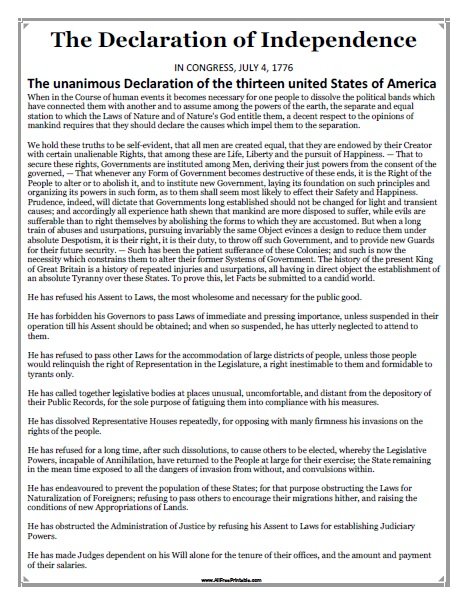

The other “self-evident” truths were adapted from John Locke’s expression “Life, Liberty and the Pursuit of Property” in Second Treatise of Government. This view rejects birth-earned authority and instead establishes the idea that only the consent of equals should determine who has power and how it is shared by different structures of government. The idea of equality reflects John Locke’s sense of political equality: all men are created equal as members of the human race with the same faculty and the same advantages from nature. When governments fail to protect these rights, the people are justified in altering their government and putting in place a new one that will function to their satisfaction. The preamble invokes the “self-evident” truths, including equality and the God-given rights of “Life, Liberty and the Pursuit of Happiness.” The Declaration then discusses an idea that is at the heart of American democracy, that is, power comes from the consent of the governed, and government is established to secure the God-given rights. Certain of God’s special dispensation, the Declaration invokes him twice in the actual proclamation of independence “for the Rectitude of our Intentions” and “with a firm Reliance on the Protection of divine Providence.”

The introduction solemnly declares the opportunity of the act, asserting that this is an inescapable moment in the history of the colonies when these need to form an independent nation to secure “the Laws of Nature and Nature’s God.” The invocation of these rights connects secular government to Christian, Calvinist theology, essentially arguing that for human laws and governments to succeed they need to conform to God’s law. The text can be divided into four parts: the introduction (the first paragraph), the preamble, the indictment of King George III and the condemnation of the British people, and the actual declaration (the last paragraph). Thomas Jefferson turned familiar expressions, phrases, and ideas from these different texts into a rhetorical and elegant tour de force affirming natural rights, portraying King George III of Great Britain as a tyrant, justifying a change of government, and declaring the United States a new nation. In his writing, he drew on commonplace philosophical and political ideas already articulated by himself and others, including A Summary View of the Rights of British America (1774) a congressional pamphlet he had helped to write in 1775 titled A Declaration of the Causes and Necessity of Taking Up Arms The Virginia Declaration of Rights (1776), drafted by James Mason and Thomas Ludwell Lee Thomas Jefferson’s own drafts of the Virginia Constitution Thomas Paine’s Common Sense (1776) the English Declaration of Rights (1688–89) and John Locke’s Second Treatise of Government (1690). Because of his reputation as a good writer, Thomas Jefferson was asked by the other members to draft the Declaration. The committee members charged with drafting the Declaration were Thomas Jefferson of Virginia, John Adams of Massachusetts, Benjamin Franklin of Pennsylvania, Roger Sherman of Connecticut, and Robert R. The Declaration of Independence is an act adopted by the Second Continental Congress in Philadelphia on July 4, 1776, proclaiming American independence from Great Britain.


 0 kommentar(er)
0 kommentar(er)
